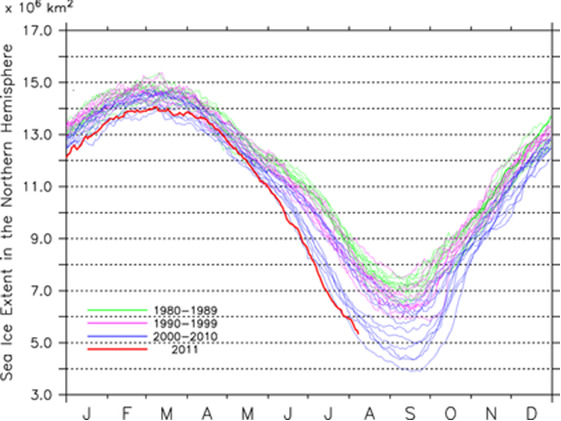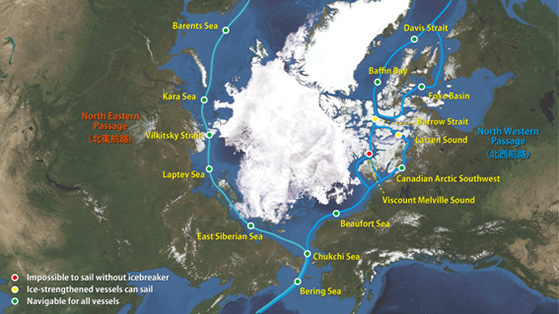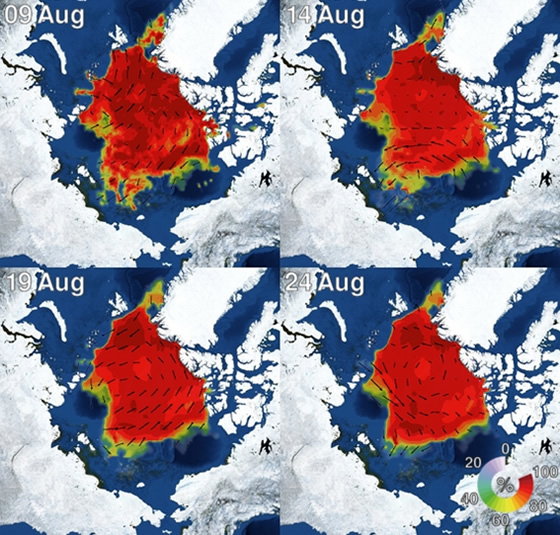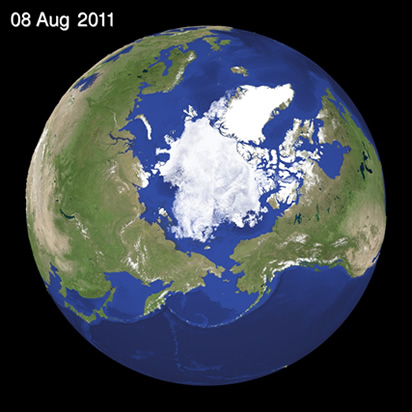2011.08.08
2011 GIC Weekly Report Vol.1
First Report for 2011: Possibility of Both Passages Opening This Year
Topic of the Week
This summer, sea ice in the Arctic is melting with the rising air temperature. Especially in the northern part of the Laptev sea, the ice is melting at a pace never seen before. Normally, there would still be ice in this region until September, blocking the northeastern passage. However, because of the early melting, the Northeastern Passage is open from August 5th for the first time.
On the other side, there is still ice along the southern route of the Northwestern Passage but it may open this month. Assuming the northern route stays open through the season, this will be the second consecutive year that both passages are open at the same time.
From this week, the Global Ice Center at Weathernews will begin sending reports on sea ice along the northern passages this summer.
Sea Ice Extent

|
Arctic Western Arctic Eastern Arctic |
Fig. 1: Surface Area of Ice Coverage in the Arctic Sea(Click to expand)
Figure 1 shows the sea ice extent in the Arctic in transition. Currently the total area is approximately 5.3 million square kilometers. This is the 2nd smallest area ever observed, closely following 5.2 million square kilometers of sea ice coverage observed in 2007. There is a trend of recession seen in the sea ice. The ice receded 0.6 million square kilometers over the last week. Looking at both the Eastern and Western hemispheres shows 2.9 million square kilometers in the Eastern hemisphere, and 2.4 million square kilometers in the Western hemisphere. This is the second smallest area observed until now. From last week, ice notably receded by approximately 0.4 million square kilometers in the Eastern hemisphere and 0.2 million square kilometers in the Western hemisphere.
Figure 2 shows the current distribution of sea ice as observed by satellite. In this image, ice extends out into the East Siberian Sea, but there is almost no ice around the Siberian Coast. In the Western hemisphere, the sea ice continues to thin around the Canadian Arctic archipelago.
Sea Ice Conditions along Polar Routes

Fig. 3: Sea Ice Conditions along Northern/Southern Passages
Figure 3 shows the possibility of a Polar Route through the arctic via the northeastern passage on the Siberian side and the northwestern passage on the Canadian side. The early opening of the northeastern passage from August 5th is still open, and is expected to stay open.
Meanwhile, ice continues to melt along the northwestern passage on the south side, with a high possibility of a both sides being open at the same time this year as last year. Ice concentration on the route from Larsen Sound to Barrow Strait has shrunk to two-tenths, and almost no ice remains in other areas. Ice remaining on the north of the northwestern passage from Viscount Melville Sound to Larsen Sound means that this passage is not open yet.
I-SEE Model Predictions
Figure 4 shows output from the I-SEE Engine model developed by Weathernews for ice-prediction. The outlook for sea ice in the Arctic is a continuing overall reduction. Along the northeastern passage, we see the possibility of the route expanding even more due to the recession of sea ice normally extending out into the East Siberian Sea. Also, there continues to be no ice in the Vilkitsky strait but there is still some ice remaining on the northern coast of Severnaya Zemlya island north of the strait. On the northwestern passage, we anticipate continued melting between Larsen Bay and Barrow Strait, and the possibility of an opening near the end of the month.

Fig 4: Sea Ice Prediction for the Arctic based on model data


